Leadership Techniques for Project Team Management and Success
VerifiedAdded on 2023/02/01
|11
|2534
|81
Report
AI Summary
This report delves into the critical aspects of leadership within project management, examining various leadership styles and their impact on team performance. It identifies the participative leadership approach as highly effective, emphasizing the inclusion of team members in decision-making. The report explores techniques to persuade project teams, including leadership qualities, decision-making skills, and conflict management. It also highlights communication tools like chat, email, and internal blogging for managing communication both within and outside the project team. Different types of power, especially expert power, are discussed for motivating teams. Furthermore, the report outlines tools and techniques for fostering self-managed teams in agile projects and identifies steps project managers can take to improve challenges, such as task delegation and employee engagement. The conclusion emphasizes the importance of effective communication and leadership strategies for achieving competitive advantages in project management.
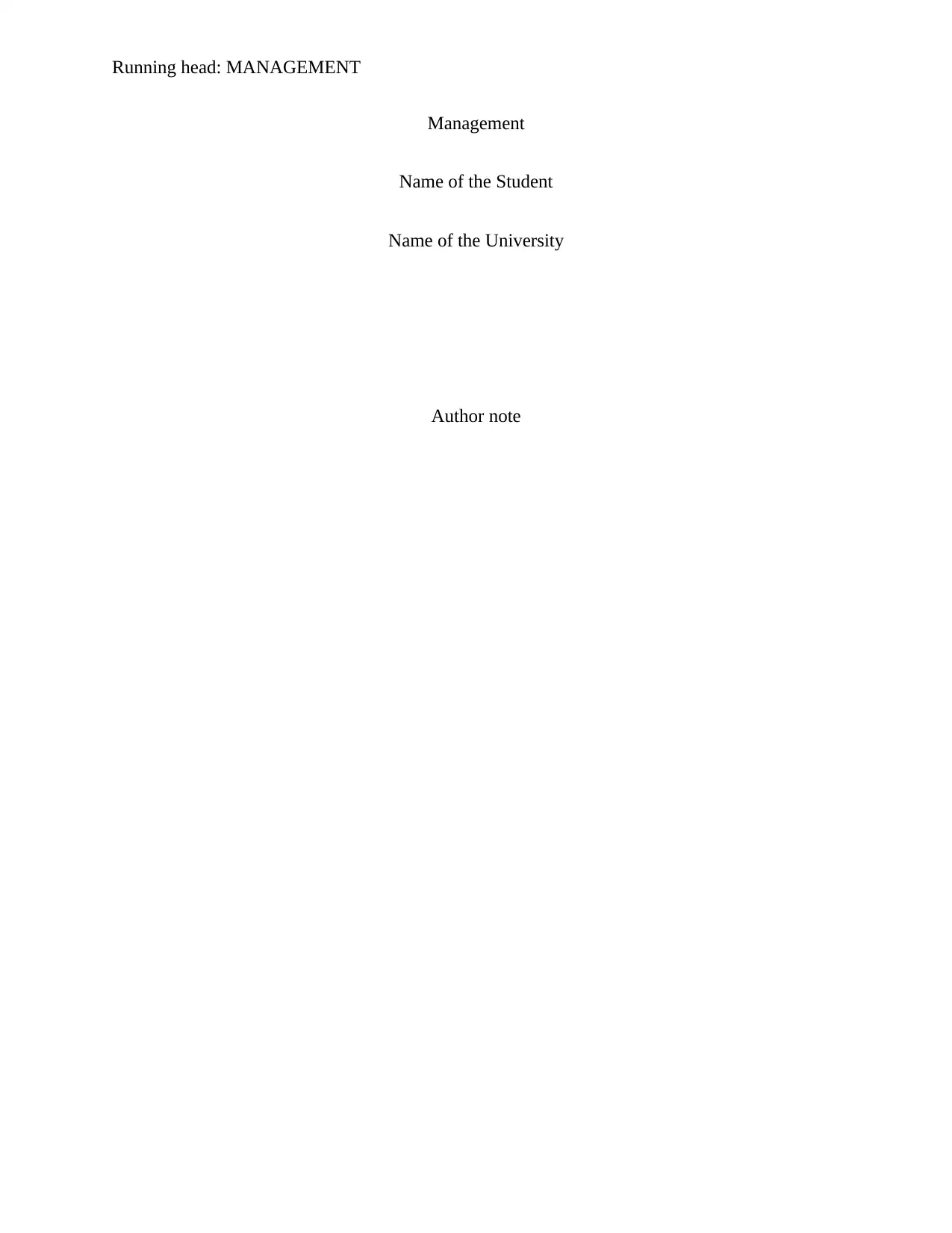
Running head: MANAGEMENT
Management
Name of the Student
Name of the University
Author note
Management
Name of the Student
Name of the University
Author note
Paraphrase This Document
Need a fresh take? Get an instant paraphrase of this document with our AI Paraphraser
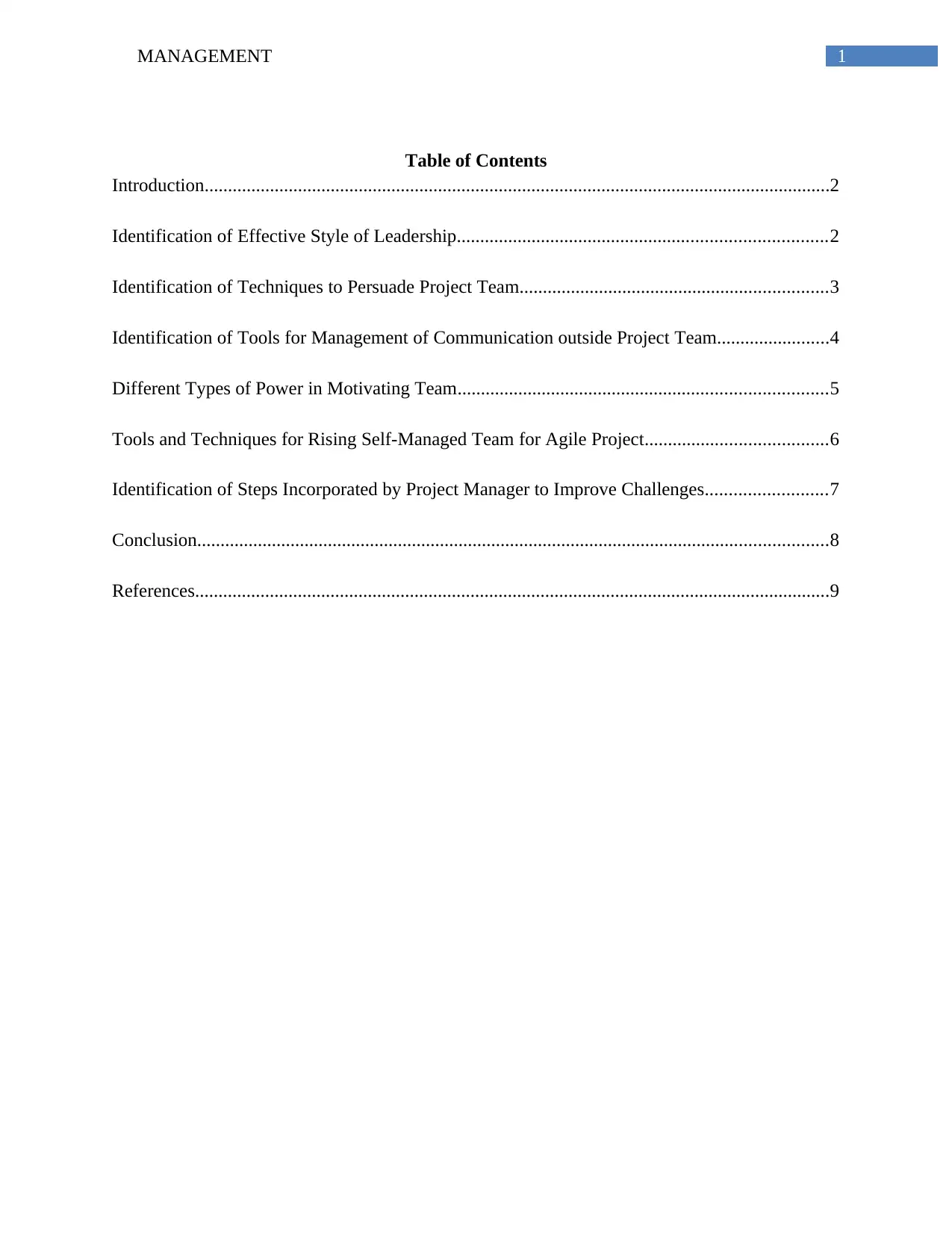
1MANAGEMENT
Table of Contents
Introduction......................................................................................................................................2
Identification of Effective Style of Leadership...............................................................................2
Identification of Techniques to Persuade Project Team..................................................................3
Identification of Tools for Management of Communication outside Project Team........................4
Different Types of Power in Motivating Team...............................................................................5
Tools and Techniques for Rising Self-Managed Team for Agile Project.......................................6
Identification of Steps Incorporated by Project Manager to Improve Challenges..........................7
Conclusion.......................................................................................................................................8
References........................................................................................................................................9
Table of Contents
Introduction......................................................................................................................................2
Identification of Effective Style of Leadership...............................................................................2
Identification of Techniques to Persuade Project Team..................................................................3
Identification of Tools for Management of Communication outside Project Team........................4
Different Types of Power in Motivating Team...............................................................................5
Tools and Techniques for Rising Self-Managed Team for Agile Project.......................................6
Identification of Steps Incorporated by Project Manager to Improve Challenges..........................7
Conclusion.......................................................................................................................................8
References........................................................................................................................................9
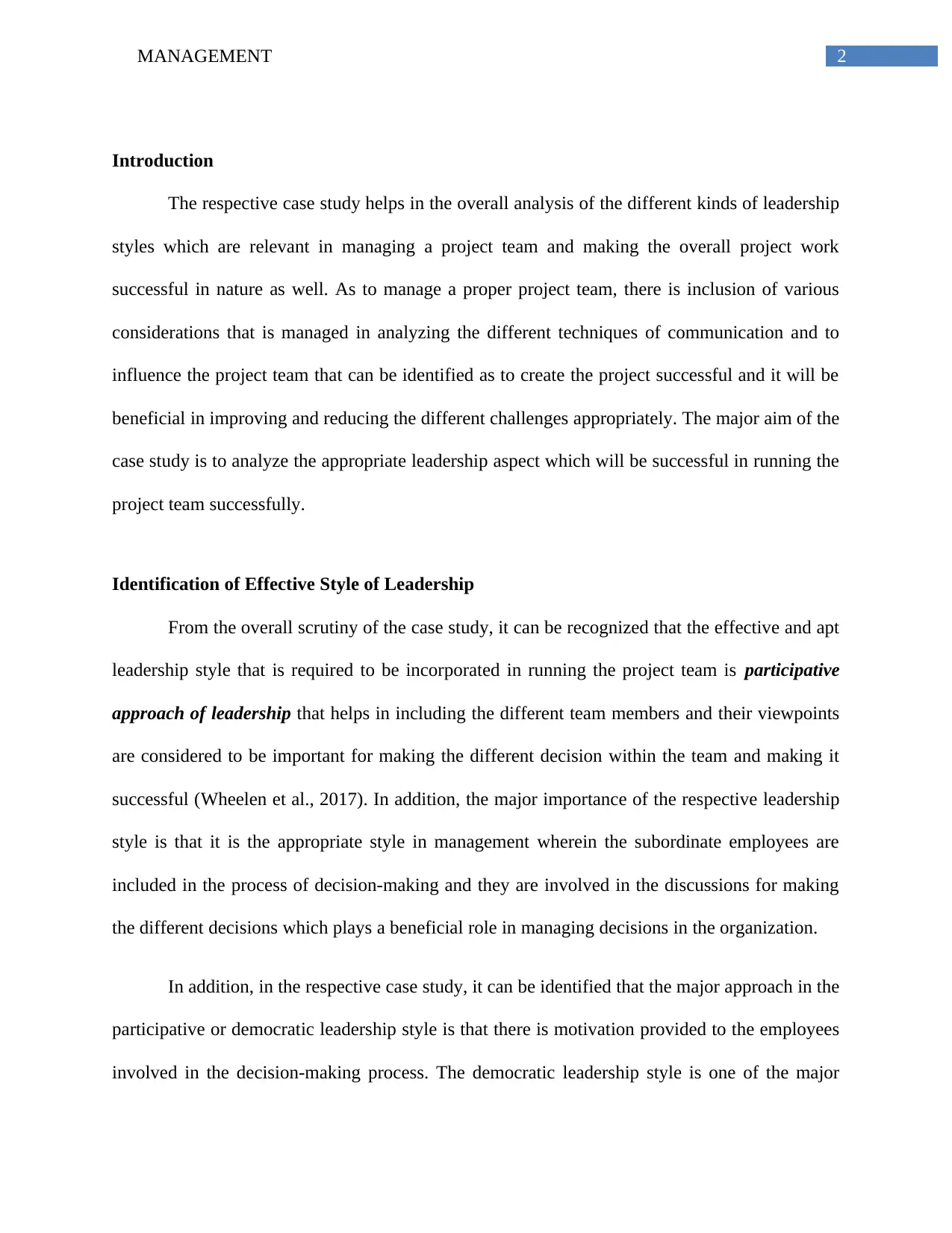
2MANAGEMENT
Introduction
The respective case study helps in the overall analysis of the different kinds of leadership
styles which are relevant in managing a project team and making the overall project work
successful in nature as well. As to manage a proper project team, there is inclusion of various
considerations that is managed in analyzing the different techniques of communication and to
influence the project team that can be identified as to create the project successful and it will be
beneficial in improving and reducing the different challenges appropriately. The major aim of the
case study is to analyze the appropriate leadership aspect which will be successful in running the
project team successfully.
Identification of Effective Style of Leadership
From the overall scrutiny of the case study, it can be recognized that the effective and apt
leadership style that is required to be incorporated in running the project team is participative
approach of leadership that helps in including the different team members and their viewpoints
are considered to be important for making the different decision within the team and making it
successful (Wheelen et al., 2017). In addition, the major importance of the respective leadership
style is that it is the appropriate style in management wherein the subordinate employees are
included in the process of decision-making and they are involved in the discussions for making
the different decisions which plays a beneficial role in managing decisions in the organization.
In addition, in the respective case study, it can be identified that the major approach in the
participative or democratic leadership style is that there is motivation provided to the employees
involved in the decision-making process. The democratic leadership style is one of the major
Introduction
The respective case study helps in the overall analysis of the different kinds of leadership
styles which are relevant in managing a project team and making the overall project work
successful in nature as well. As to manage a proper project team, there is inclusion of various
considerations that is managed in analyzing the different techniques of communication and to
influence the project team that can be identified as to create the project successful and it will be
beneficial in improving and reducing the different challenges appropriately. The major aim of the
case study is to analyze the appropriate leadership aspect which will be successful in running the
project team successfully.
Identification of Effective Style of Leadership
From the overall scrutiny of the case study, it can be recognized that the effective and apt
leadership style that is required to be incorporated in running the project team is participative
approach of leadership that helps in including the different team members and their viewpoints
are considered to be important for making the different decision within the team and making it
successful (Wheelen et al., 2017). In addition, the major importance of the respective leadership
style is that it is the appropriate style in management wherein the subordinate employees are
included in the process of decision-making and they are involved in the discussions for making
the different decisions which plays a beneficial role in managing decisions in the organization.
In addition, in the respective case study, it can be identified that the major approach in the
participative or democratic leadership style is that there is motivation provided to the employees
involved in the decision-making process. The democratic leadership style is one of the major
⊘ This is a preview!⊘
Do you want full access?
Subscribe today to unlock all pages.

Trusted by 1+ million students worldwide
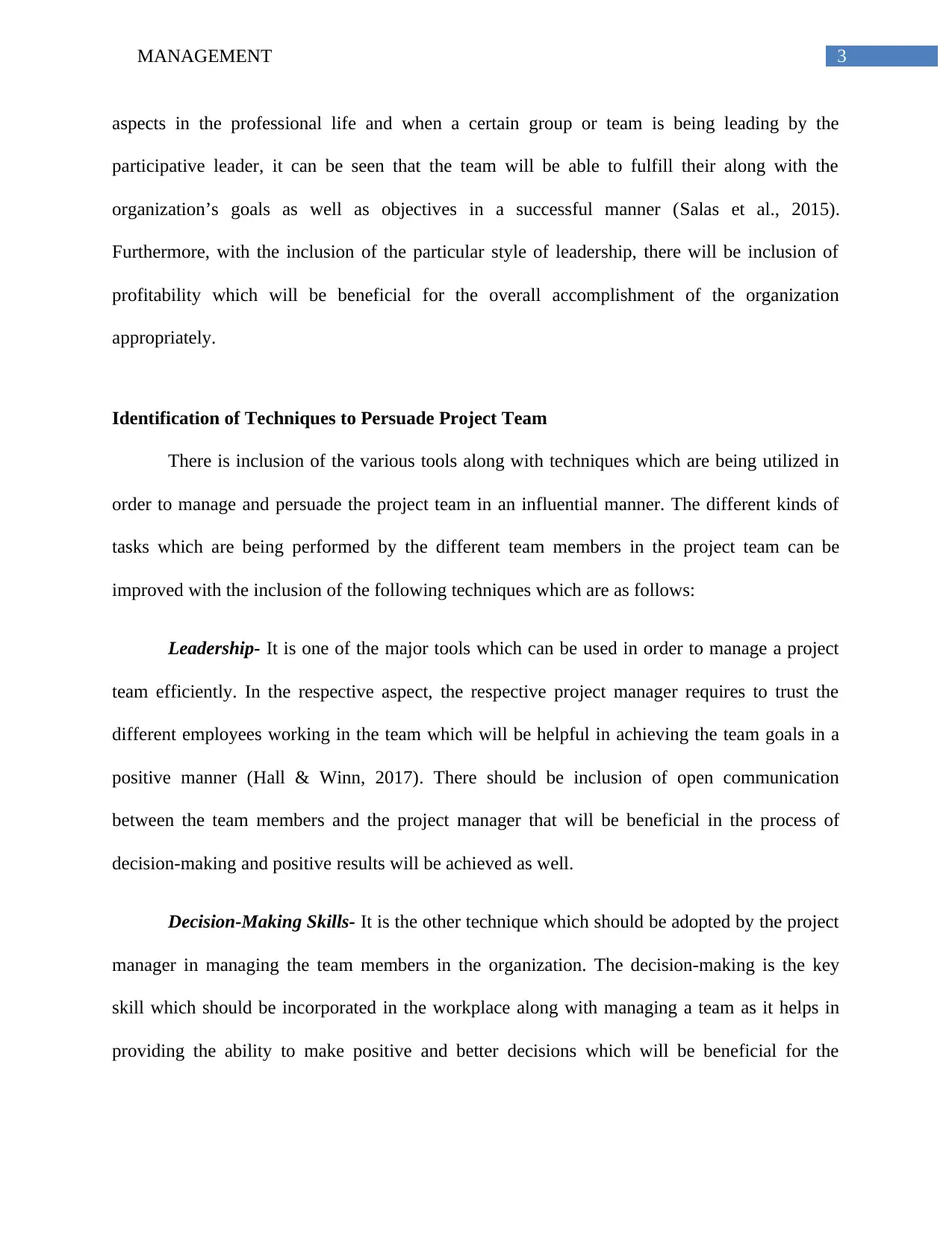
3MANAGEMENT
aspects in the professional life and when a certain group or team is being leading by the
participative leader, it can be seen that the team will be able to fulfill their along with the
organization’s goals as well as objectives in a successful manner (Salas et al., 2015).
Furthermore, with the inclusion of the particular style of leadership, there will be inclusion of
profitability which will be beneficial for the overall accomplishment of the organization
appropriately.
Identification of Techniques to Persuade Project Team
There is inclusion of the various tools along with techniques which are being utilized in
order to manage and persuade the project team in an influential manner. The different kinds of
tasks which are being performed by the different team members in the project team can be
improved with the inclusion of the following techniques which are as follows:
Leadership- It is one of the major tools which can be used in order to manage a project
team efficiently. In the respective aspect, the respective project manager requires to trust the
different employees working in the team which will be helpful in achieving the team goals in a
positive manner (Hall & Winn, 2017). There should be inclusion of open communication
between the team members and the project manager that will be beneficial in the process of
decision-making and positive results will be achieved as well.
Decision-Making Skills- It is the other technique which should be adopted by the project
manager in managing the team members in the organization. The decision-making is the key
skill which should be incorporated in the workplace along with managing a team as it helps in
providing the ability to make positive and better decisions which will be beneficial for the
aspects in the professional life and when a certain group or team is being leading by the
participative leader, it can be seen that the team will be able to fulfill their along with the
organization’s goals as well as objectives in a successful manner (Salas et al., 2015).
Furthermore, with the inclusion of the particular style of leadership, there will be inclusion of
profitability which will be beneficial for the overall accomplishment of the organization
appropriately.
Identification of Techniques to Persuade Project Team
There is inclusion of the various tools along with techniques which are being utilized in
order to manage and persuade the project team in an influential manner. The different kinds of
tasks which are being performed by the different team members in the project team can be
improved with the inclusion of the following techniques which are as follows:
Leadership- It is one of the major tools which can be used in order to manage a project
team efficiently. In the respective aspect, the respective project manager requires to trust the
different employees working in the team which will be helpful in achieving the team goals in a
positive manner (Hall & Winn, 2017). There should be inclusion of open communication
between the team members and the project manager that will be beneficial in the process of
decision-making and positive results will be achieved as well.
Decision-Making Skills- It is the other technique which should be adopted by the project
manager in managing the team members in the organization. The decision-making is the key
skill which should be incorporated in the workplace along with managing a team as it helps in
providing the ability to make positive and better decisions which will be beneficial for the
Paraphrase This Document
Need a fresh take? Get an instant paraphrase of this document with our AI Paraphraser
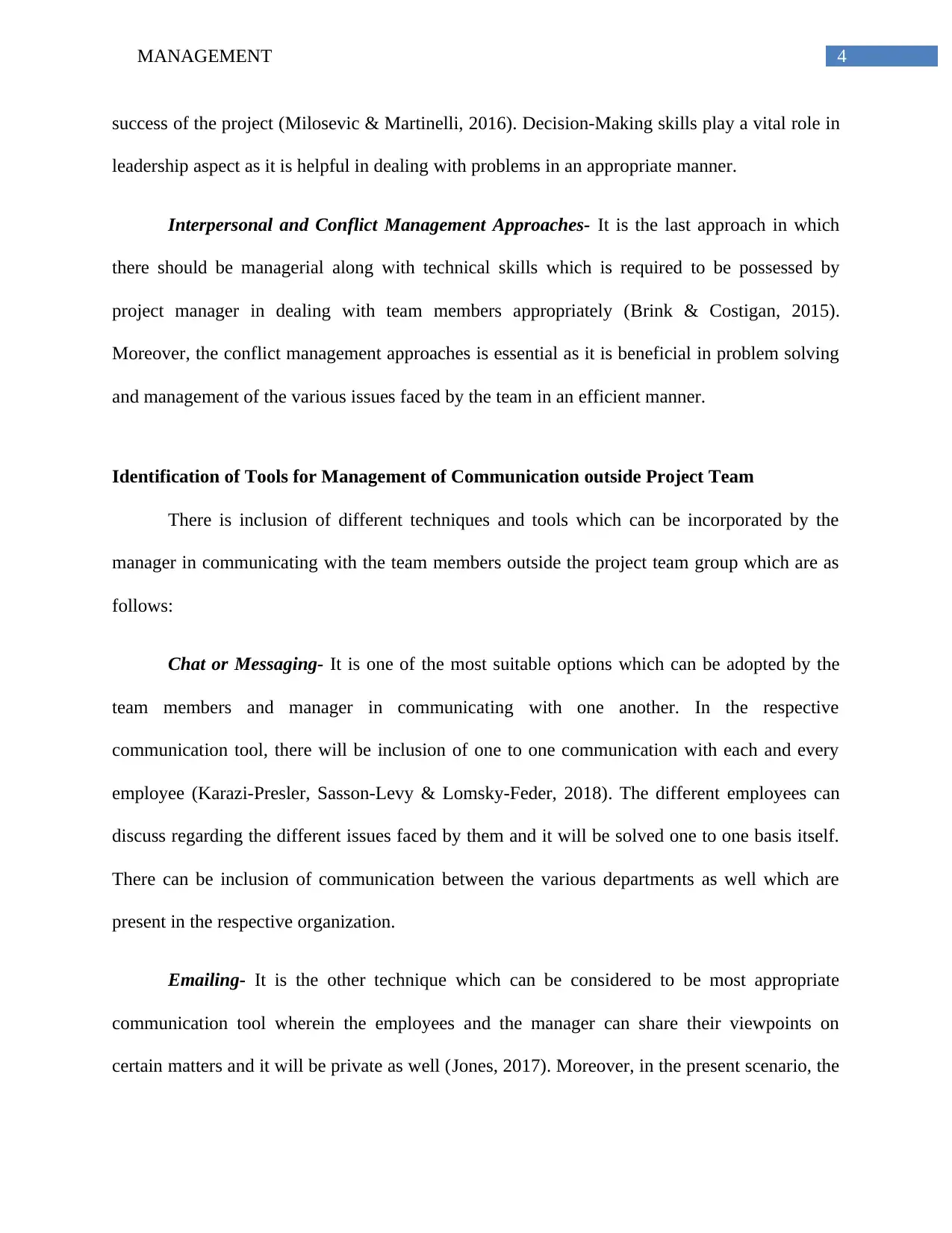
4MANAGEMENT
success of the project (Milosevic & Martinelli, 2016). Decision-Making skills play a vital role in
leadership aspect as it is helpful in dealing with problems in an appropriate manner.
Interpersonal and Conflict Management Approaches- It is the last approach in which
there should be managerial along with technical skills which is required to be possessed by
project manager in dealing with team members appropriately (Brink & Costigan, 2015).
Moreover, the conflict management approaches is essential as it is beneficial in problem solving
and management of the various issues faced by the team in an efficient manner.
Identification of Tools for Management of Communication outside Project Team
There is inclusion of different techniques and tools which can be incorporated by the
manager in communicating with the team members outside the project team group which are as
follows:
Chat or Messaging- It is one of the most suitable options which can be adopted by the
team members and manager in communicating with one another. In the respective
communication tool, there will be inclusion of one to one communication with each and every
employee (Karazi-Presler, Sasson-Levy & Lomsky-Feder, 2018). The different employees can
discuss regarding the different issues faced by them and it will be solved one to one basis itself.
There can be inclusion of communication between the various departments as well which are
present in the respective organization.
Emailing- It is the other technique which can be considered to be most appropriate
communication tool wherein the employees and the manager can share their viewpoints on
certain matters and it will be private as well (Jones, 2017). Moreover, in the present scenario, the
success of the project (Milosevic & Martinelli, 2016). Decision-Making skills play a vital role in
leadership aspect as it is helpful in dealing with problems in an appropriate manner.
Interpersonal and Conflict Management Approaches- It is the last approach in which
there should be managerial along with technical skills which is required to be possessed by
project manager in dealing with team members appropriately (Brink & Costigan, 2015).
Moreover, the conflict management approaches is essential as it is beneficial in problem solving
and management of the various issues faced by the team in an efficient manner.
Identification of Tools for Management of Communication outside Project Team
There is inclusion of different techniques and tools which can be incorporated by the
manager in communicating with the team members outside the project team group which are as
follows:
Chat or Messaging- It is one of the most suitable options which can be adopted by the
team members and manager in communicating with one another. In the respective
communication tool, there will be inclusion of one to one communication with each and every
employee (Karazi-Presler, Sasson-Levy & Lomsky-Feder, 2018). The different employees can
discuss regarding the different issues faced by them and it will be solved one to one basis itself.
There can be inclusion of communication between the various departments as well which are
present in the respective organization.
Emailing- It is the other technique which can be considered to be most appropriate
communication tool wherein the employees and the manager can share their viewpoints on
certain matters and it will be private as well (Jones, 2017). Moreover, in the present scenario, the

5MANAGEMENT
approach of email is the most common aspects which is considered to be informal and it is
suitable for communicating.
Internal Blogging- It is the last aspect which can be considered to be suitable as it is
helpful in sharing and expressing the different ideas and learning about one another in an open
forum (Iqbal, Anwar & Haider, 2015). There is inclusion of discussion regarding the work which
is being performed and the different viewpoints of all the employees from various departments
are welcomed. Moreover, there can be delegation of the tasks as well in accordance with the
different potential of the employees.
Different Types of Power in Motivating Team
The power is one of the most essential aspects which can be utilized in achieving and
accomplishing the different objectives (Grundy, 2017). The different executives and managers
utilize the different kinds of power in motivating the subordinates and it helps in increasing the
overall productivity of the organization in a positive manner as well. The various kinds of power
include the following:
Reward Power
Expert Power
Legitimate Power
Referent Power
Coercive Power
From the above, it can be identified that these are the five major powers which are being
utilized in the organization in managing different situations. In the respective scenario, the power
which is relevant is Expert Power that helps in providing the leaders with the robust kind of
approach of email is the most common aspects which is considered to be informal and it is
suitable for communicating.
Internal Blogging- It is the last aspect which can be considered to be suitable as it is
helpful in sharing and expressing the different ideas and learning about one another in an open
forum (Iqbal, Anwar & Haider, 2015). There is inclusion of discussion regarding the work which
is being performed and the different viewpoints of all the employees from various departments
are welcomed. Moreover, there can be delegation of the tasks as well in accordance with the
different potential of the employees.
Different Types of Power in Motivating Team
The power is one of the most essential aspects which can be utilized in achieving and
accomplishing the different objectives (Grundy, 2017). The different executives and managers
utilize the different kinds of power in motivating the subordinates and it helps in increasing the
overall productivity of the organization in a positive manner as well. The various kinds of power
include the following:
Reward Power
Expert Power
Legitimate Power
Referent Power
Coercive Power
From the above, it can be identified that these are the five major powers which are being
utilized in the organization in managing different situations. In the respective scenario, the power
which is relevant is Expert Power that helps in providing the leaders with the robust kind of
⊘ This is a preview!⊘
Do you want full access?
Subscribe today to unlock all pages.

Trusted by 1+ million students worldwide
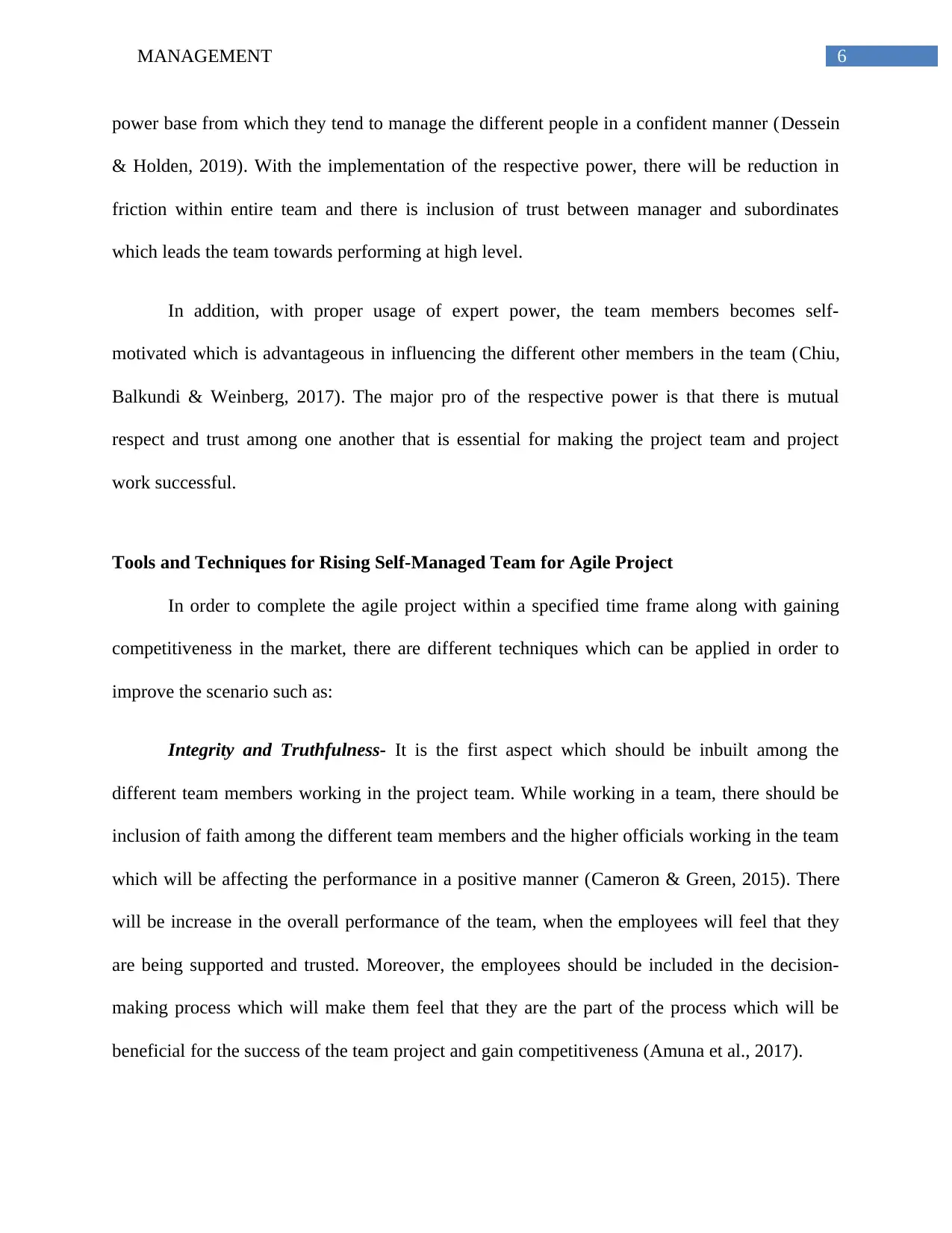
6MANAGEMENT
power base from which they tend to manage the different people in a confident manner (Dessein
& Holden, 2019). With the implementation of the respective power, there will be reduction in
friction within entire team and there is inclusion of trust between manager and subordinates
which leads the team towards performing at high level.
In addition, with proper usage of expert power, the team members becomes self-
motivated which is advantageous in influencing the different other members in the team (Chiu,
Balkundi & Weinberg, 2017). The major pro of the respective power is that there is mutual
respect and trust among one another that is essential for making the project team and project
work successful.
Tools and Techniques for Rising Self-Managed Team for Agile Project
In order to complete the agile project within a specified time frame along with gaining
competitiveness in the market, there are different techniques which can be applied in order to
improve the scenario such as:
Integrity and Truthfulness- It is the first aspect which should be inbuilt among the
different team members working in the project team. While working in a team, there should be
inclusion of faith among the different team members and the higher officials working in the team
which will be affecting the performance in a positive manner (Cameron & Green, 2015). There
will be increase in the overall performance of the team, when the employees will feel that they
are being supported and trusted. Moreover, the employees should be included in the decision-
making process which will make them feel that they are the part of the process which will be
beneficial for the success of the team project and gain competitiveness (Amuna et al., 2017).
power base from which they tend to manage the different people in a confident manner (Dessein
& Holden, 2019). With the implementation of the respective power, there will be reduction in
friction within entire team and there is inclusion of trust between manager and subordinates
which leads the team towards performing at high level.
In addition, with proper usage of expert power, the team members becomes self-
motivated which is advantageous in influencing the different other members in the team (Chiu,
Balkundi & Weinberg, 2017). The major pro of the respective power is that there is mutual
respect and trust among one another that is essential for making the project team and project
work successful.
Tools and Techniques for Rising Self-Managed Team for Agile Project
In order to complete the agile project within a specified time frame along with gaining
competitiveness in the market, there are different techniques which can be applied in order to
improve the scenario such as:
Integrity and Truthfulness- It is the first aspect which should be inbuilt among the
different team members working in the project team. While working in a team, there should be
inclusion of faith among the different team members and the higher officials working in the team
which will be affecting the performance in a positive manner (Cameron & Green, 2015). There
will be increase in the overall performance of the team, when the employees will feel that they
are being supported and trusted. Moreover, the employees should be included in the decision-
making process which will make them feel that they are the part of the process which will be
beneficial for the success of the team project and gain competitiveness (Amuna et al., 2017).
Paraphrase This Document
Need a fresh take? Get an instant paraphrase of this document with our AI Paraphraser

7MANAGEMENT
Self-Driven and Determined Employees- It is the other technique which can be adopted
by the project team in which such employees should be included who are self driven and they are
determined in completing the project in a successful manner. However, in order to incorporate
proper and successful team, it is essential for the different superiors in the workplace to
showcase that they trust employees and they will be trusting their skills related to decision-
making which will play a major role to improve business operations in a successful manner as
well (Fiaz, Su & Saqib, 2017).
Identification of Steps Incorporated by Project Manager to Improve Challenges
There various techniques that will be incorporated by the respective project manager in
improving the different challenges and improving them appropriately are:
Task Delegation- It is one of the appropriate steps which can be helpful in improving
challenges wherein the respective tasks will be assigned as per the different employees who are
having knowledge in the respective domain. Proper distribution of the tasks is assigning the
authority as well as responsibility to empower the different employees or team members (Fiaz,
Su & Saqib, 2017).
Engagement among Employees- It is the other aspect which can play a major role in
improving the challenges wherein in the process of decision-making; the different employees
will be involved which plays a major role in managing the different tasks.
Open Forum Meetings- In the respective aspect there is inclusion of aspects which helps
in improving the challenges in which the different poor performance of the employees will be
discussed and appropriate solutions can be suggested to improve the confusion as well (Fiaz, Su
& Saqib, 2017).
Self-Driven and Determined Employees- It is the other technique which can be adopted
by the project team in which such employees should be included who are self driven and they are
determined in completing the project in a successful manner. However, in order to incorporate
proper and successful team, it is essential for the different superiors in the workplace to
showcase that they trust employees and they will be trusting their skills related to decision-
making which will play a major role to improve business operations in a successful manner as
well (Fiaz, Su & Saqib, 2017).
Identification of Steps Incorporated by Project Manager to Improve Challenges
There various techniques that will be incorporated by the respective project manager in
improving the different challenges and improving them appropriately are:
Task Delegation- It is one of the appropriate steps which can be helpful in improving
challenges wherein the respective tasks will be assigned as per the different employees who are
having knowledge in the respective domain. Proper distribution of the tasks is assigning the
authority as well as responsibility to empower the different employees or team members (Fiaz,
Su & Saqib, 2017).
Engagement among Employees- It is the other aspect which can play a major role in
improving the challenges wherein in the process of decision-making; the different employees
will be involved which plays a major role in managing the different tasks.
Open Forum Meetings- In the respective aspect there is inclusion of aspects which helps
in improving the challenges in which the different poor performance of the employees will be
discussed and appropriate solutions can be suggested to improve the confusion as well (Fiaz, Su
& Saqib, 2017).
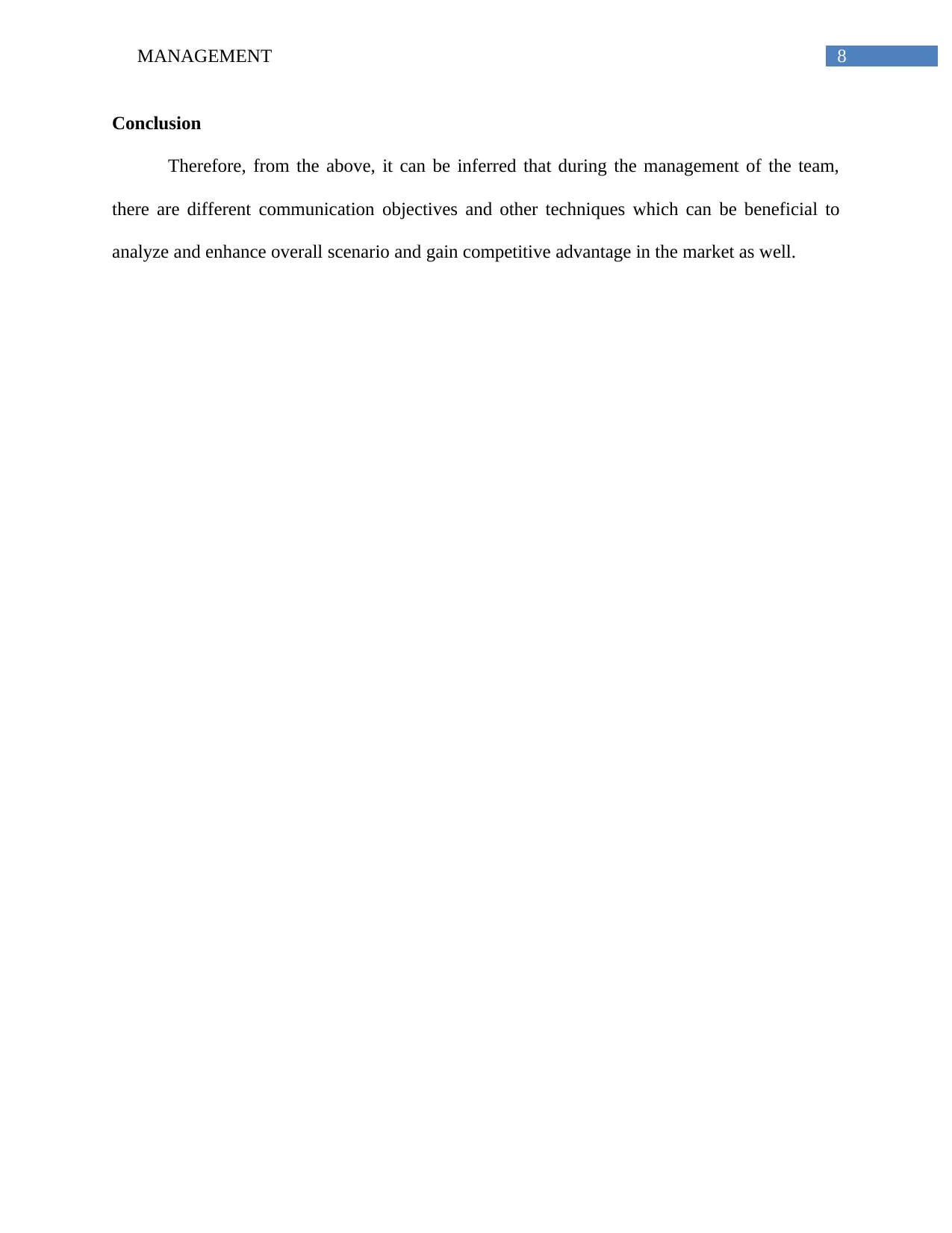
8MANAGEMENT
Conclusion
Therefore, from the above, it can be inferred that during the management of the team,
there are different communication objectives and other techniques which can be beneficial to
analyze and enhance overall scenario and gain competitive advantage in the market as well.
Conclusion
Therefore, from the above, it can be inferred that during the management of the team,
there are different communication objectives and other techniques which can be beneficial to
analyze and enhance overall scenario and gain competitive advantage in the market as well.
⊘ This is a preview!⊘
Do you want full access?
Subscribe today to unlock all pages.

Trusted by 1+ million students worldwide
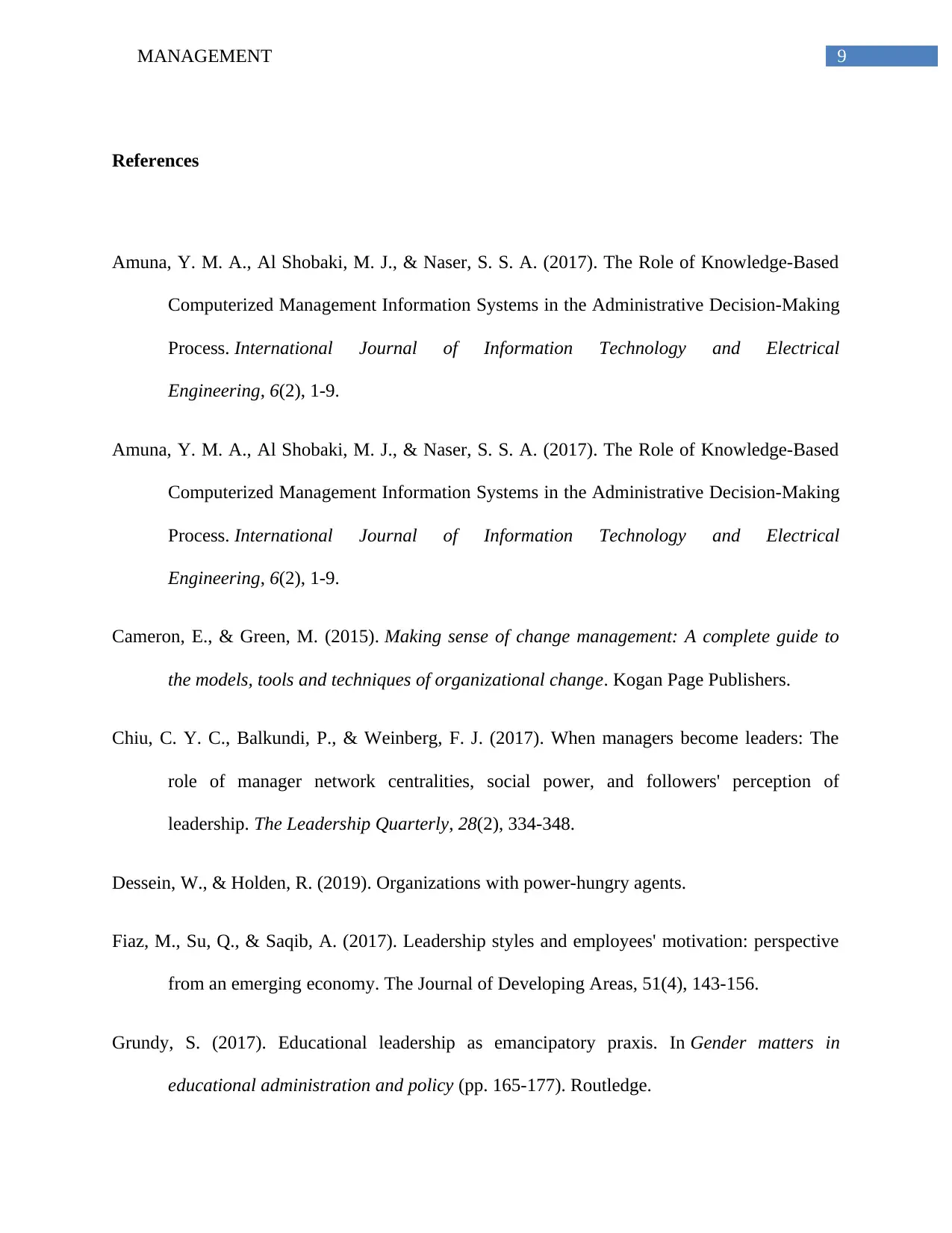
9MANAGEMENT
References
Amuna, Y. M. A., Al Shobaki, M. J., & Naser, S. S. A. (2017). The Role of Knowledge-Based
Computerized Management Information Systems in the Administrative Decision-Making
Process. International Journal of Information Technology and Electrical
Engineering, 6(2), 1-9.
Amuna, Y. M. A., Al Shobaki, M. J., & Naser, S. S. A. (2017). The Role of Knowledge-Based
Computerized Management Information Systems in the Administrative Decision-Making
Process. International Journal of Information Technology and Electrical
Engineering, 6(2), 1-9.
Cameron, E., & Green, M. (2015). Making sense of change management: A complete guide to
the models, tools and techniques of organizational change. Kogan Page Publishers.
Chiu, C. Y. C., Balkundi, P., & Weinberg, F. J. (2017). When managers become leaders: The
role of manager network centralities, social power, and followers' perception of
leadership. The Leadership Quarterly, 28(2), 334-348.
Dessein, W., & Holden, R. (2019). Organizations with power-hungry agents.
Fiaz, M., Su, Q., & Saqib, A. (2017). Leadership styles and employees' motivation: perspective
from an emerging economy. The Journal of Developing Areas, 51(4), 143-156.
Grundy, S. (2017). Educational leadership as emancipatory praxis. In Gender matters in
educational administration and policy (pp. 165-177). Routledge.
References
Amuna, Y. M. A., Al Shobaki, M. J., & Naser, S. S. A. (2017). The Role of Knowledge-Based
Computerized Management Information Systems in the Administrative Decision-Making
Process. International Journal of Information Technology and Electrical
Engineering, 6(2), 1-9.
Amuna, Y. M. A., Al Shobaki, M. J., & Naser, S. S. A. (2017). The Role of Knowledge-Based
Computerized Management Information Systems in the Administrative Decision-Making
Process. International Journal of Information Technology and Electrical
Engineering, 6(2), 1-9.
Cameron, E., & Green, M. (2015). Making sense of change management: A complete guide to
the models, tools and techniques of organizational change. Kogan Page Publishers.
Chiu, C. Y. C., Balkundi, P., & Weinberg, F. J. (2017). When managers become leaders: The
role of manager network centralities, social power, and followers' perception of
leadership. The Leadership Quarterly, 28(2), 334-348.
Dessein, W., & Holden, R. (2019). Organizations with power-hungry agents.
Fiaz, M., Su, Q., & Saqib, A. (2017). Leadership styles and employees' motivation: perspective
from an emerging economy. The Journal of Developing Areas, 51(4), 143-156.
Grundy, S. (2017). Educational leadership as emancipatory praxis. In Gender matters in
educational administration and policy (pp. 165-177). Routledge.
Paraphrase This Document
Need a fresh take? Get an instant paraphrase of this document with our AI Paraphraser
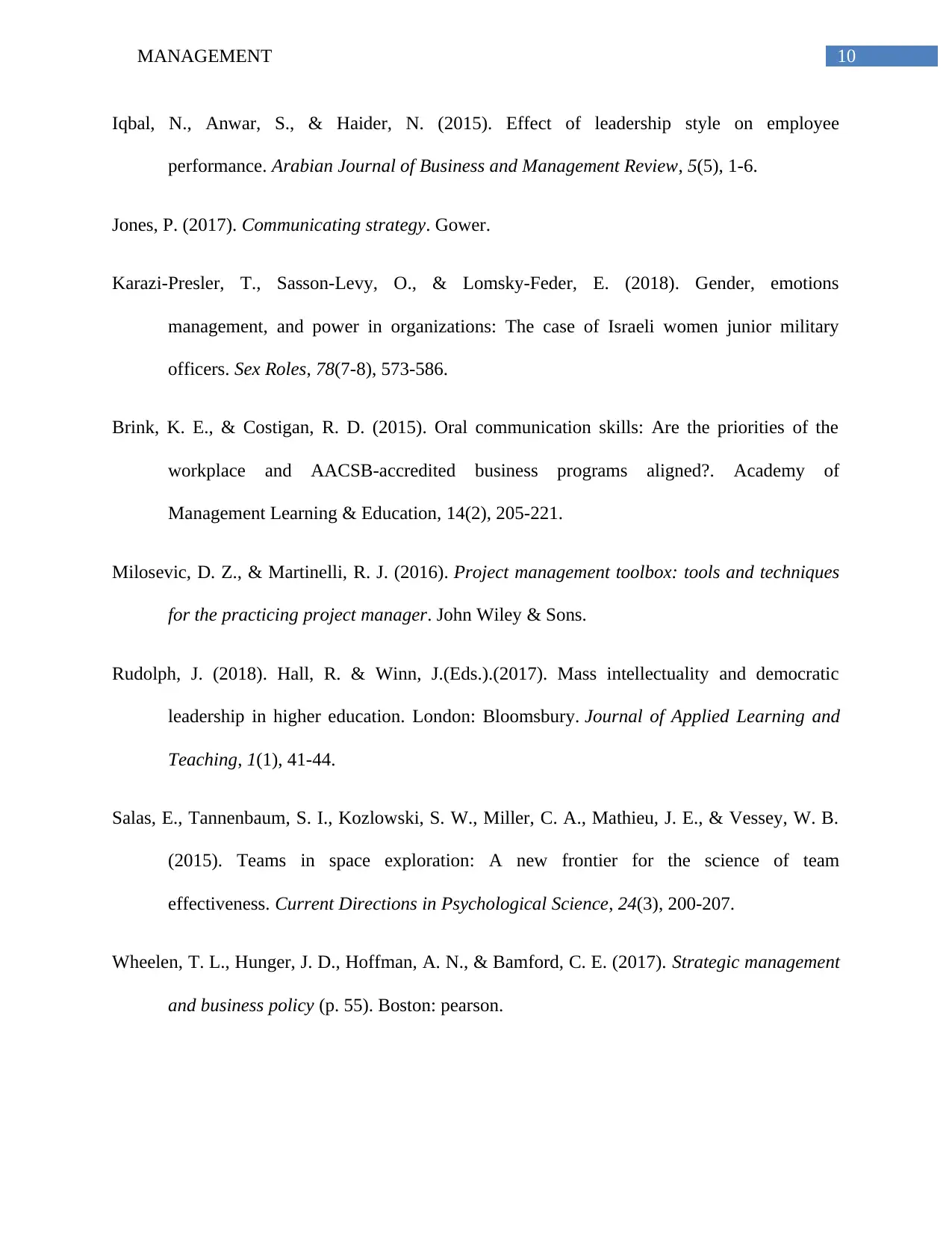
10MANAGEMENT
Iqbal, N., Anwar, S., & Haider, N. (2015). Effect of leadership style on employee
performance. Arabian Journal of Business and Management Review, 5(5), 1-6.
Jones, P. (2017). Communicating strategy. Gower.
Karazi-Presler, T., Sasson-Levy, O., & Lomsky-Feder, E. (2018). Gender, emotions
management, and power in organizations: The case of Israeli women junior military
officers. Sex Roles, 78(7-8), 573-586.
Brink, K. E., & Costigan, R. D. (2015). Oral communication skills: Are the priorities of the
workplace and AACSB-accredited business programs aligned?. Academy of
Management Learning & Education, 14(2), 205-221.
Milosevic, D. Z., & Martinelli, R. J. (2016). Project management toolbox: tools and techniques
for the practicing project manager. John Wiley & Sons.
Rudolph, J. (2018). Hall, R. & Winn, J.(Eds.).(2017). Mass intellectuality and democratic
leadership in higher education. London: Bloomsbury. Journal of Applied Learning and
Teaching, 1(1), 41-44.
Salas, E., Tannenbaum, S. I., Kozlowski, S. W., Miller, C. A., Mathieu, J. E., & Vessey, W. B.
(2015). Teams in space exploration: A new frontier for the science of team
effectiveness. Current Directions in Psychological Science, 24(3), 200-207.
Wheelen, T. L., Hunger, J. D., Hoffman, A. N., & Bamford, C. E. (2017). Strategic management
and business policy (p. 55). Boston: pearson.
Iqbal, N., Anwar, S., & Haider, N. (2015). Effect of leadership style on employee
performance. Arabian Journal of Business and Management Review, 5(5), 1-6.
Jones, P. (2017). Communicating strategy. Gower.
Karazi-Presler, T., Sasson-Levy, O., & Lomsky-Feder, E. (2018). Gender, emotions
management, and power in organizations: The case of Israeli women junior military
officers. Sex Roles, 78(7-8), 573-586.
Brink, K. E., & Costigan, R. D. (2015). Oral communication skills: Are the priorities of the
workplace and AACSB-accredited business programs aligned?. Academy of
Management Learning & Education, 14(2), 205-221.
Milosevic, D. Z., & Martinelli, R. J. (2016). Project management toolbox: tools and techniques
for the practicing project manager. John Wiley & Sons.
Rudolph, J. (2018). Hall, R. & Winn, J.(Eds.).(2017). Mass intellectuality and democratic
leadership in higher education. London: Bloomsbury. Journal of Applied Learning and
Teaching, 1(1), 41-44.
Salas, E., Tannenbaum, S. I., Kozlowski, S. W., Miller, C. A., Mathieu, J. E., & Vessey, W. B.
(2015). Teams in space exploration: A new frontier for the science of team
effectiveness. Current Directions in Psychological Science, 24(3), 200-207.
Wheelen, T. L., Hunger, J. D., Hoffman, A. N., & Bamford, C. E. (2017). Strategic management
and business policy (p. 55). Boston: pearson.
1 out of 11
Related Documents
Your All-in-One AI-Powered Toolkit for Academic Success.
+13062052269
info@desklib.com
Available 24*7 on WhatsApp / Email
![[object Object]](/_next/static/media/star-bottom.7253800d.svg)
Unlock your academic potential
Copyright © 2020–2025 A2Z Services. All Rights Reserved. Developed and managed by ZUCOL.





